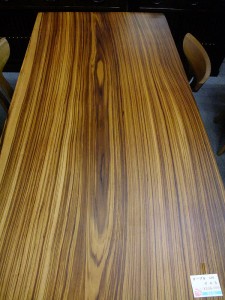Now that’s a table! Zebrawood tends to be quite expensive, because quarter-sawn sections are required to achieve its distinctive look.
Trade Name: Zebrawood, Zebrano.
Genus: Microberlinia brazzavillensis
Janka Hardness (pounds-force): 2097
Description: Highly contrasting growth rings, resulting in the name from its quarter-sawn sections. Wildly chaotic sections may also be found from flat-sawn sections of Zebrano. The texture is fairly coarse, and its grain is usually wavy in nature.
Location: West Africa, namely: Cameroon, Congo, Gabon, Equatorial Guinea. Zebrawood’s availability is further limited by the accessibility of the stock. Zebrano is found in remote locales, and is a slow growing species, with lots of cull from the milled to finished product.
Common Aliases: African zebrawood, Amouk, Enuk-enug, Zebrano, Izingana.
Performance: Cuts well, but does not plane quite so easily due to the wildly contrasting nature of the product. Stinks, but it only stinks like Zebrano. Zebrawood glues and finishes well, so presumably, once the product is well sealed, the odor encountered during the woodworking can be remedied. This isn’t a wood I would much want to put outside (personal preference…I wouldn’t want to smell rotting Zebrano), but it is a durable wood suitable for outdoor use. Insects don’t like the smell, or the taste of it.
If you’re already having trouble seeing, AND you read Japanese, AND you need something to rapidly accelerate your vision loss, these should turn the trick.
Common Uses: Eyeglasses, decorative objects, flooring, furnishings, cabinetry, pens, plywood, veneers, turnings, and anything else that as a piece of furnishing needs to scream just a little bit.
From: The Wood Database:
Common Name(s): Zebrawood, Zebrano
Scientific Name: Microberlinia brazzavillensis
Distribution: West Africa
Tree Size: 150 ft (46 m) tall, 4-5 ft (1.2-1.5 m) trunk diameter
Average Dried Weight: 54 lbs/ft3 (860 kg/m3)
Basic Specific Gravity: .64
Hardness: 2,097 lbf (9.330 N)
Rupture Strength: 20,000 lbf/in2 (137,900 kPa)
Elastic Strength: 2,340,000 lbf/in2 (16,100 MPa)
Crushing Strength: 9,600 lbf/in2 (66.2 MPa)
Shrinkage: Radial: 6.8%, Tangential: 11.5%, Volumetric: 16.5%, T/R Ratio: 1.7

